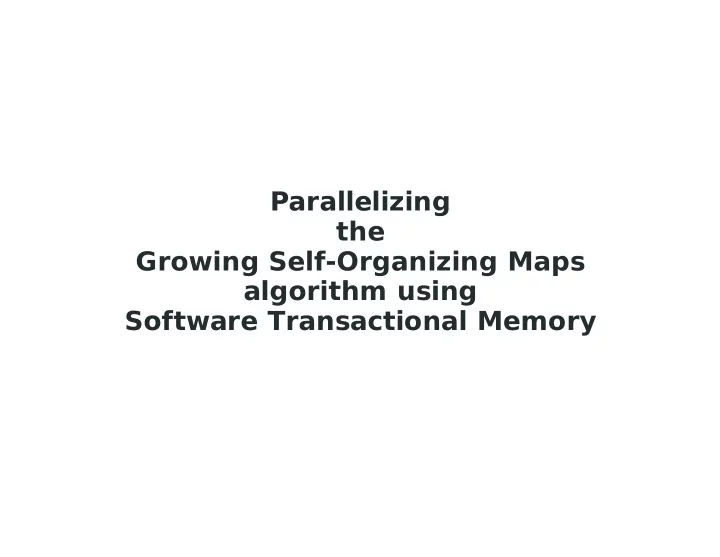

Parallelizing the Growing Self-Organizing Maps algorithm using Software Transactional Memory
Growing Self-Organizing Maps Is a clustering algorithm.
Growing Self-Organizing Maps So for example this is what the input looks like:
Growing Self-Organizing Maps And this is the output you would get:
Growing Self-Organizing Maps Bonus: output is a planar graph.
Growing Self-Organizing Maps So how to you generate this output?
Growing Self-Organizing Maps For each input point point ... p
Growing Self-Organizing Maps you find the closest node in the output graph ... n p
Growing Self-Organizing Maps and pull every node in a neighborhood of closer to . n ′ n p p
Growing Self-Organizing Maps Growth: start with a minimal number of nodes, keep track of the accumulated error for each node, check whether it exceeds a certain threshold, propagate the error to neighbours for internal nodes, create new neighbours for boundary nodes.
Growing Self-Organizing Maps Parallelization: this thing is slow (~ ), n 2 O ( ) need to exploit parallelization potential, special case considered here: Multiprocessor/Multicore systems, not GPUs, no distributed computing.
Growing Self-Organizing Maps No problem:
Growing Self-Organizing Maps Problem:
Growing Self-Organizing Maps Problem:
Growing Self-Organizing Maps Problem: need a way to synchronize parallel tasks. Traditional solution: locks, semaphores, critical sections, get complex quickly, don't compose, error prone (deadlocks, livelocks, resource starvation, priority inversion)
Growing Self-Organizing Maps Deadlock example (do you see the solution?):
Growing Self-Organizing Maps Deadlock example (do you see the solution?) Or: use a different concurrency abstraction, namely Software Transactional Memory.
Software Transactional Memory is a concurrency abstraction that: brings transaction semantics known from databases to software/programming, was proposed in the 95s, can be implemented VERY differently, is easier to reason about than locking, keeps a shared memory model, doesn't use user level locks, is still an area of research.
Software Transactional Memory Swapping the values of two variables: swap a b = atomically (do value_a <- readTVar a value_b <- readTVar b writeTVar b value_a writeTVar a value_b)
Software Transactional Memory also has limits: transactions mean restarts, restarts disallow side effects, restarts can have surprising performance characteristics. Haskell's implementation: controls side effects through the type system, doesn't use locking, uses an optimistic approach.
Applying STM to GSOM means figuring out: thread granularity, transaction granularity, invariants between transactions.
Applying STM to GSOM Thread granularity: one point per thread. p Transaction granularity: figure out in one transaction , n p ( T 1 ) move and its neighbors closer to in another . n p p ( T 2 )
Applying STM to GSOM Transaction invariant: has minimum distance to at the end of and at n p p T 1 the beginning of , T 2 is ensured by keeping track of pairs in a lookup ( p , n p ) table , t checking whenever a node is modified and updating t n if necessary, t modifications happen only during , T 2 transaction semantics guarantee correctness.
Results: Around 20% speedup for 2 dimensions, 2 threads and 2 cores. Why so slow? most expensive transaction is , T 1 is highly likely to be restarted, T 1 restarts kill performance gains.
Results: Even worse for higher dimensions (i.e. around 200): running time degenerates to being unusable. But for this scenario a different parallelization strategy would be more appropriate: parallelize distance measure calculations (possibly on GPUs).
Thank you for your patience!
Recommend
More recommend